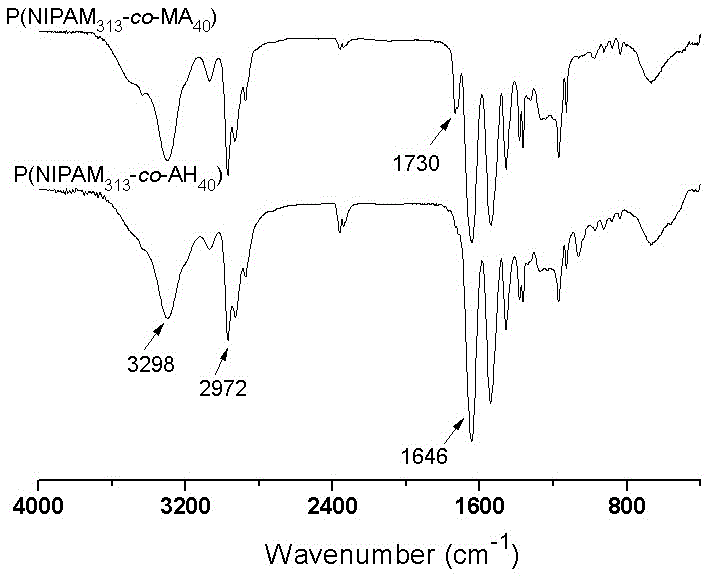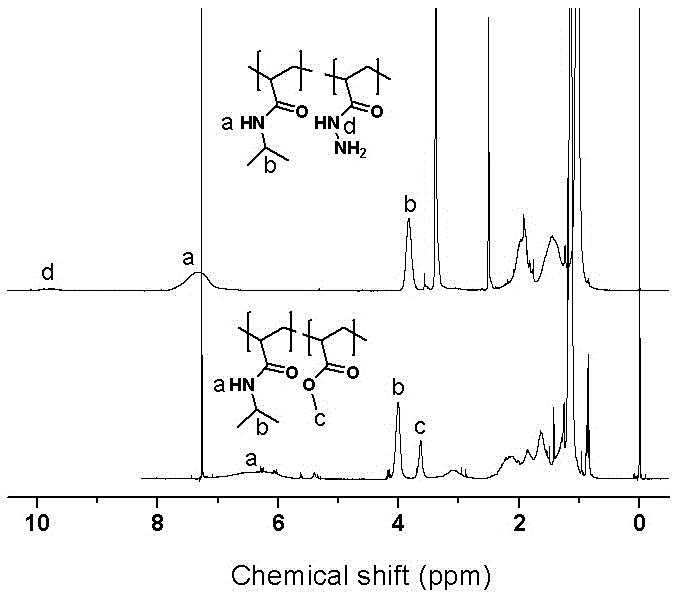Temperature-sensitive self-repairing hydrogel and preparation method and application thereof
A self-healing and temperature-sensitive technology, which is applied in the field of temperature-sensitive self-healing hydrogel and its preparation, can solve the problems that temperature-sensitive hydrogel cannot achieve self-healing, etc., so as to prolong the service life, broad application prospects, good stability effect
- Summary
- Abstract
- Description
- Claims
- Application Information
AI Technical Summary
Problems solved by technology
Method used
Image
Examples
preparation example Construction
[0046] The embodiment of the present invention also discloses a method for preparing a temperature-sensitive self-healing hydrogel, including the following steps:
[0047] a, copolymerization, 100 parts by weight of isopropylacrylamide and 5 to 400 parts (preferably 5 to 100 parts) of acrylate compounds are dissolved in a solvent, and free radical copolymerization (preferably living free radical polymerization) ), the reaction temperature is 30-120°C (preferably 60-100°C), the reaction time is 2-24h, preferably (12-24h), after the polymerization is completed, a precipitant is added to the reaction solution, and the residual monomer is removed by precipitation. (N-isopropylacrylamide)-acrylate copolymer was obtained. Among them, the acrylate compound is methyl acrylate, methyl methacrylate, ethyl acrylate, ethyl methacrylate, butyl acrylate, butyl methacrylate, hydroxyethyl acrylate or hydroxyethyl methacrylate One or more, preferably acrylate; the solvent used is N,N-dimethyl...
Embodiment 1
[0051] Copolymerization: 10g NIPAM, 1g methyl acrylate, 5mg azobisisobutyronitrile (AIBN) and 50mg DDMAT chain transfer agent (i.e. dodecyl trithiocarbonate) were dissolved in 15mL dioxane, and Add it into a 50mL reaction flask, remove the oxygen in the system, and raise the temperature to 60°C under magnetic stirring to carry out reversible addition-fragmentation chain transfer radical polymerization. The reaction time is 24h. After the reaction, cool the reaction system, and use petroleum ether Precipitate twice, remove unreacted monomer, and vacuum dry to obtain white powder, which is NIPAM-methyl acrylate copolymer. Calculate the monomer conversion rate and average molecular weight by weighing. The repeating unit NIPAM and repeating unit methyl acrylate in the copolymer The mass ratio is about 10:1.
[0052] Hydrazinolysis: Dissolve 5g of the above copolymer in a mixed solvent of 5mL ethanol and 10mL hydrazine hydrate, raise the temperature to 80°C, and perform hydrazinoly...
Embodiment 2
[0060] Copolymerization: 10g NIPAM, 40g methyl acrylate, 5mg azobisisobutyronitrile (AIBN) and 50mg CPDB chain transfer agent (i.e. cyanoisopropyl dithiobenzoate) were dissolved in 50mL dioxane, and Add it into a 100mL reaction bottle, remove the oxygen in the system, and raise the temperature to 60°C under magnetic stirring to perform reversible addition-fragmentation chain transfer radical polymerization. The reaction time is 24h. After the reaction is completed, cool the reaction system and use petroleum The ether was precipitated twice to remove unreacted monomers, and vacuum dried to obtain a light yellow powder, which was NIPAM-methyl acrylate copolymer. The monomer conversion rate and average molecular weight were calculated by weighing, and the mass ratio of the two repeating units in the polymer was about It is 1:4.
[0061] Hydrazinolysis: Dissolve 5g of the above-mentioned copolymer in 10mL of methanol, then add 10mL of hydrazine hydrate, heat up to 80°C, hydrazinol...
PUM
 Login to View More
Login to View More Abstract
Description
Claims
Application Information
 Login to View More
Login to View More - R&D
- Intellectual Property
- Life Sciences
- Materials
- Tech Scout
- Unparalleled Data Quality
- Higher Quality Content
- 60% Fewer Hallucinations
Browse by: Latest US Patents, China's latest patents, Technical Efficacy Thesaurus, Application Domain, Technology Topic, Popular Technical Reports.
© 2025 PatSnap. All rights reserved.Legal|Privacy policy|Modern Slavery Act Transparency Statement|Sitemap|About US| Contact US: help@patsnap.com



